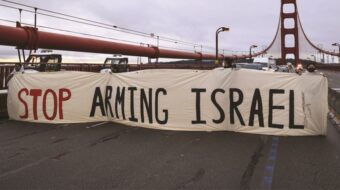
News reports this week suggest that seven months after the beginning of the Russian invasion, Ukraine has seized the initiative. We read in the press that neither President Vladimir Putin nor the people around him expected that their “special military operation” would evolve into a war that would still be raging half-a-year later.
We read that they believed the Ukrainian resistance would be crushed right away. We hear that Russia is continuing to carry out serious war crimes and that Putin is threatening to use nuclear weapons.
On the matter of the war dragging out much longer than expected, no one should be surprised. When you combine the incredible Ukrainian military resistance with the unprecedented infusion of billions of dollars in high-tech and sophisticated weaponry by the U.S. and its NATO allies, a quick Russian victory was never going to happen.
It is difficult to imagine, however, that Russian intelligence could have been so poor as not to expect both the resistance in Ukraine and the limitless infusion of arms. The invasion has become both a Russia-Ukraine war and, significantly and perhaps even more ominous for the entire world, a U.S.-Russia war.
We have reports that, in an address to the Russian people, Putin declared his country is prepared to use everything it has available, including nuclear weapons, in this conflict. Back in 1982, Soviet leader Leonid Brezhnev pledged that the USSR would never be the first to use nuclear weapons. Former Russian President Boris Yeltsin tossed that commitment in 1993, and Putin said in 2020 that his country reserved the right to use nukes if its territory was ever attacked.
His restatement of that policy again this week is even more dangerous, however, than it was when he and Yeltsin said it in the past. And that’s because of a particularly complicating factor in this potential atomic mess: the votes being held in what the media are calling the “sham referenda” in four regions of Russian-controlled Ukrainian territory in the east and south.

It is expected that the results will indicate, as per Putin’s plan, that the people in those regions want to officially become part of Russia, not independent republics or autonomous areas.
If Ukraine then attacks those areas in an attempt to reclaim them, Putin wants to be able to say they are attacking the territory of Russia itself, allowing him to employ even harsher “defensive” methods against Ukraine, up to and including nuclear retaliation.
As outrageous as that statement was, there was one part of Putin’s speech to his people that was correct. That is the part where he said Russia was fighting a powerful Western military machine dominated by the United States.
The latter confrontation did not start with the Russian invasion of Ukraine; it has been well underway for many years. On the nuclear danger, in particular, the fight involved the U.S. placement of planes, missiles, and other weapons that can deliver nukes in countries all along the western border of Russia.
Many of those nuclear-capable weapons and delivery systems arrived before and in the year leading up to the Russian invasion of Ukraine. For a long time prior to the current war, there was plenty of talk in the West about Ukraine eventually joining NATO and the EU, some of whose members already harbor nuclear weapons pointed at Russia.
In recent years, the U.S. unilaterally ended the remaining post-Cold War nuclear arms reduction treaties between itself and the Soviet Union, and later with Russia. The U.S and Russia are the world’s two largest nuclear powers, and the cancellation of the only treaties between them was, arguably, at least as reckless as any threats Putin made last week. Throwing those agreements in the trash opened the door to the deadly potential of endless nuclear escalation.
There’s also the fact that just before Putin’s latest speech, the U.S. general formerly in charge of U.S. Army troops in Europe, Ben Hodges, announced that once Ukraine wins the current war, the next step should be the dismantlement of the Russian state, piece by piece. Former Polish President Lech Walesa also called this past summer for the break up of Russia, saying its population should be reduced to “less than 50 million inhabitants.” The country’s current population is over 140 million.
So while the Russian invasion of Ukraine is certainly a criminal act, Putin has a point when he says the U.S. has been charging ahead on a confrontational track for a long time. He also was not off the wall when he worried Ukraine might join other NATO countries in hosting U.S.-made nuclear weapons.
Does all of that excuse Putin’s latest nuclear one-upmanship? Of course no, but it does help understand what’s happening and why.

As for the rest of his war effort, Putin made a serious error, being an imperialist and autocrat himself, by not calculating the extent to which U.S. imperialism would pour conventional weapons, logistical support, training, and intelligence services into Ukraine, aimed at making it impossible for Russia to win its war.
By declaring a new troop call-up last week, involving some 300,000 draftees, reservists, and former military personnel, and by reorienting the Russian economy toward a long-term war footing, Putin tests domestic support for not only the war but also his own presidency.
News reports and social media posts suggest people in Russia are beginning to resist this latest move with fresh demonstrations across the country—the first since the initial anti-war protests were held (and suppressed) immediately after the invasion.
The entire situation is making it impossible for pro-peace forces in both Ukraine and Russia to know what to do.
In Russia, those who oppose the war face detention and repression. In Ukraine, too, peace activists face arrest or even death, as they are branded traitors to the nation.
What do you do if you are living in one of the regions where the referenda are happening when a team from the board of elections shows up at your door with ballots, accompanied by an armed Russian soldier?
Is he there to protect the election workers who might be attacked by Ukrainian guerilla fighters, or is he there to intimidate you into casting a yes vote? Similarly, when right-wing Ukrainian militia fighters arrive in the neighborhood, are they coming to your aid or to kill you?
According to the Associated Press, members of the “Yellow Ribbon” guerrilla group have spread leaflets threatening those who cast ballots and urged residents to send photos and video of people who vote so they can be tracked down later. The guerrillas also posted phone numbers of election commission chiefs in the Kherson region, calling on pro-Ukraine activists to “make their life unbearable.”
Just over a week ago, a deputy head of the Berdyansk city administration and his wife who headed the city election commission were killed in an attack. So the threat is not just a rhetorical one.
If you are a civilian who votes, you could be in trouble from the “traitor-hunting” Ukrainian paramilitary forces; if you don’t vote, you may fear retaliation from the Russians. It is a lose-lose dilemma for the people trapped in the war zone.

Similarly, if you lived in an area the Russians occupied but which has now been retaken by Ukrainian fighters, you face a problem. When the Ukrainian troops re-entered Kharkiv, which had been taken over by the Russians, they were initially greeted by grateful civilians doling out dumplings and food treats.
Soon after, many villagers, including some who had welcomed the Ukrainian troops back, found themselves being rounded up by militia guerrillas accusing them of having collaborated with Russians. Even teachers who had simply returned to work in their classrooms to teach children during the Russian occupation were accused of collaboration.
The situation is awful in a country where, to begin with, before the invasion, half the population spoke Ukrainian and the other half Russian. Life was already hell for many Ukrainians living in the eastern regions even before Putin’s troops crossed the border in February.
For the killing in these areas did not begin with the Russian invasion. Before that, some 14,000 Ukrainians in the east had been killed by other Ukrainians who supported the government in Kiev. Russian-speaking Ukrainians stopped hearing their language spoken anywhere in the media, schools, or public life several years ago.
Its no exaggeration to say that U.S imperialism has not made any of these situations any better. In fact, the U.S. supported the coup in Ukraine that triggered what amounted to a civil war in the east back in 2014.
U.S. arms producers and fossil fuel companies have made a financial killing in this war. The fracked gas companies in the U.S. are now selling their gas to Europe, having pushed the Russian gas companies out of the market, and the weapons makers, of course, have a war that is more lucrative for them by the month than even the Afghanistan war was.
The Communist Party USA’s position, in agreement with the position of many communist parties around the world, is that in order to defuse the nuclear war danger and end the killing in Ukraine, there must be an immediate ceasefire followed by diplomatic negotiations.
The U.S. must stop flooding weapons into the conflict, an action that only inflames the situation and pours oil on the fire. The Russian invasion must stop in its tracks and, troops should be withdrawn.
Some say a ceasefire and negotiations are not possible until after the Russians leave Ukraine entirely. Sticking to this position, come what may, is not necessarily a formula for peace. Talks can begin even before that happens.
Negotiations are possible. There have been major prisoner exchanges already, and these have resulted from unconditional negotiations between Ukraine and Russia. Black Sea blockades on grain shipments have been lifted due to talks, allowing grain and other foodstuffs exports for both countries for customers in Africa and South Asia that needed them badly. Now the discussions have to be extended to the issue of permanently ending the hostilities.
The United States should be supporting negotiations rather than inflaming the situation by giving carte blanche to NATO to extend its military right up to the borders of Russia, and it must stop sending in armaments.
The U.S. and Russia should also negotiate an end to the hostility between them, a hostility that is unacceptable between the two largest nuclear powers in the world. The world cannot allow the escalation we saw last week to continue.
U.S. imperialism is determined to back Ukraine no matter the results. Russia is determined to continue the fight to achieve its goals, no matter what. The result of this could well be a permanent and irreversible break between Russia and Europe and between Russia and the U.S.
Indicative of this danger is the fact that Putin is well aware that none of the regions that vote in a time of war to join the Russian Federation will be internationally recognized, but in the context of an irreversible break between Russia and the West, that does not matter to him.

And criticism by the West matters little to him because Russia, unfortunately, can point to hypocrisy in Washington when it comes to matters such as respect for international law and internationally-recognized borders. Those are things the entire world should respect, but leaders in Washington cannot expect people to take them seriously when U.S. imperialism regularly throws out treaties and stations weapons in countries all over the world.
The U.S. demands Russian adherence to U.N. resolutions on Ukraine, for instance, but pays no attention to U.N. resolutions that condemn U.S. colonialism in Puerto Rico and elsewhere.
It’s also worth remembering that it is only the U.S., not Russia or China, that regularly places nuclear weapons in other countries.
After the fall of the Berlin Wall in 1989, the U.S. promised the Soviet Union that NATO would not expand eastward, but that pledge was tossed. The dominant position in the U.S. and the West, as far as Russia is concerned, is that it (Russia) needs to be dismantled and destroyed.
Though many don’t want to hear it, this stance by the U.S. and the West is a root cause of the war in Ukraine, more so than the alleged desire of an “insane” man in charge of the Kremlin to reclaim the Soviet “empire.”
First, there was no Soviet “empire,” and second, it was the collapse of the Soviet Union, in fact, that helped U.S. imperialism gain the confidence needed to impose U.S. dictates on an increasing number of countries in the 1990s and 2000s.

By discounting Ukrainian willingness and ability to resist, and underestimating the fact that the U.S. would not stop pumping in weaponry, regardless of how many Ukrainians die, Putin helped back not just himself but Russia into a corner.
It is still impossible to tell, however, where on the battlefield this war will ultimately go. The only certainty is that, at the very least, many more Ukrainians and Russians will die.
Will this horrific situation escalate even further, possibly into nuclear conflict? Worry about that is very much on the table right now.
What is not yet on the table, however, are the negotiations called for by the CPUSA, other communist parties, and peace organizations in Ukraine, Russia, Europe, and around the world.
The lack of diplomacy right now is, for all of us, the worst aspect of a war that is no longer merely being waged over the future of Ukraine and Russia, but over the future of the entire world.
As with all op-eds published by People’s World, this article reflects the opinions of its authors.













Comments